Abstract
The effects of acupuncture on health are generally hard to assess. Stimulation of the P6 acupuncture point is used to obtain an antiemetic effect and this provides an excellent model to study the efficacy of acupuncture. Thirty-three controlled trials have been published worldwide in which the P6 acupuncture point was stimulated for treatment of nausea and/or vomiting associated with chemotherapy, pregnancy, or surgery. P6 acupuncture was equal or inferior to control in all four trials in which it was administered under anaesthesia; in 27 of the remaining 29 trials acupuncture was statistically superior. A second analysis was restricted to 12 high-quality randomized placebo-controlled trials in which P6 acupuncture point stimulation was not administered under anaesthesia. Eleven of these trials, involving nearly 2000 patients, showed an effect of P6. The reviewed papers showed consistent results across different investigators, different groups of patients, and different forms of acupuncture point stimulation. Except when administered under anaesthesia, P6 acupuncture point stimulation seems to be an effective antiemetic technique. Researchers are faced with a choice between deciding that acupuncture does have specific effects, and changing from 'Does acupuncture work?' to a set of more practical questions; or deciding that the evidence on P6 antiemesis does not provide sufficient proof, and specifying what would constitute acceptable evidence.
Full text
PDF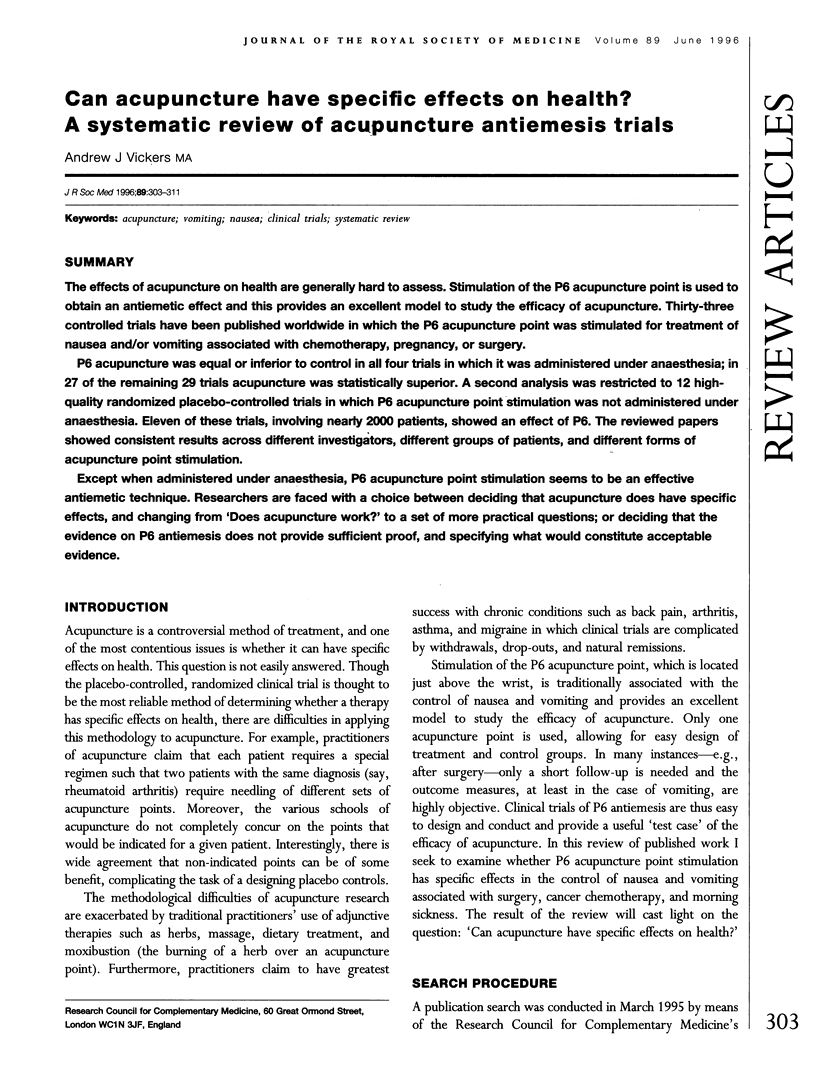
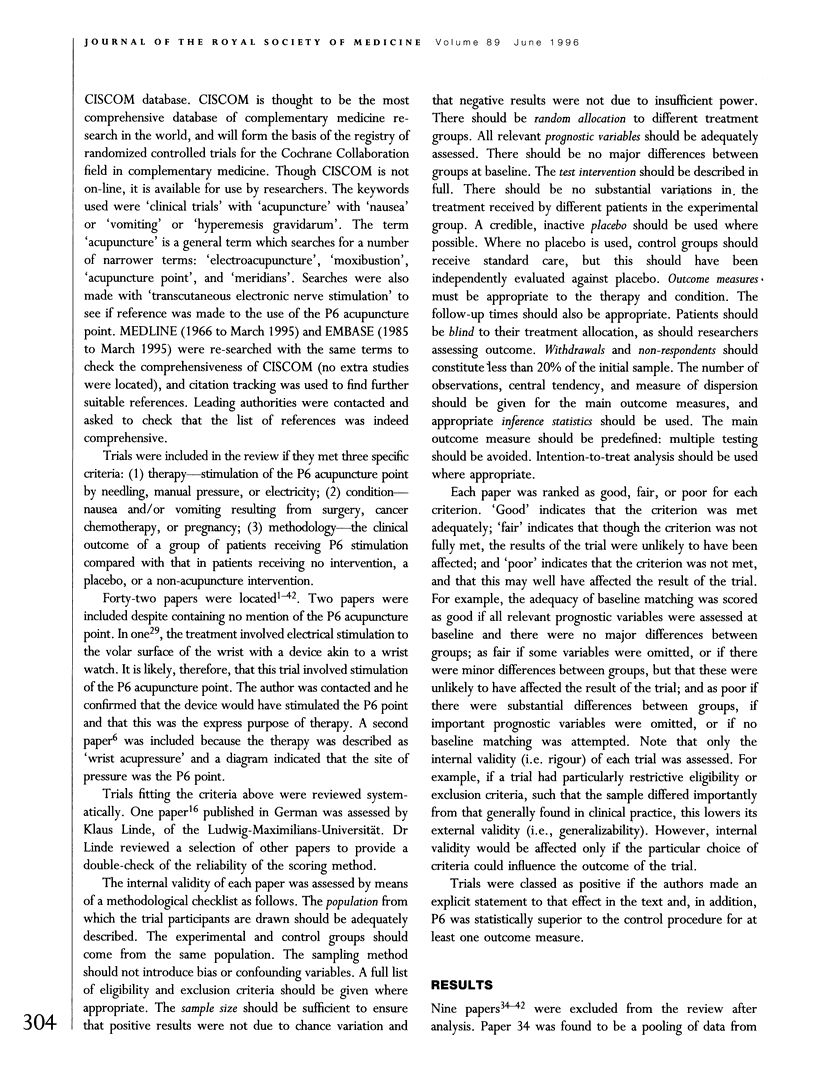
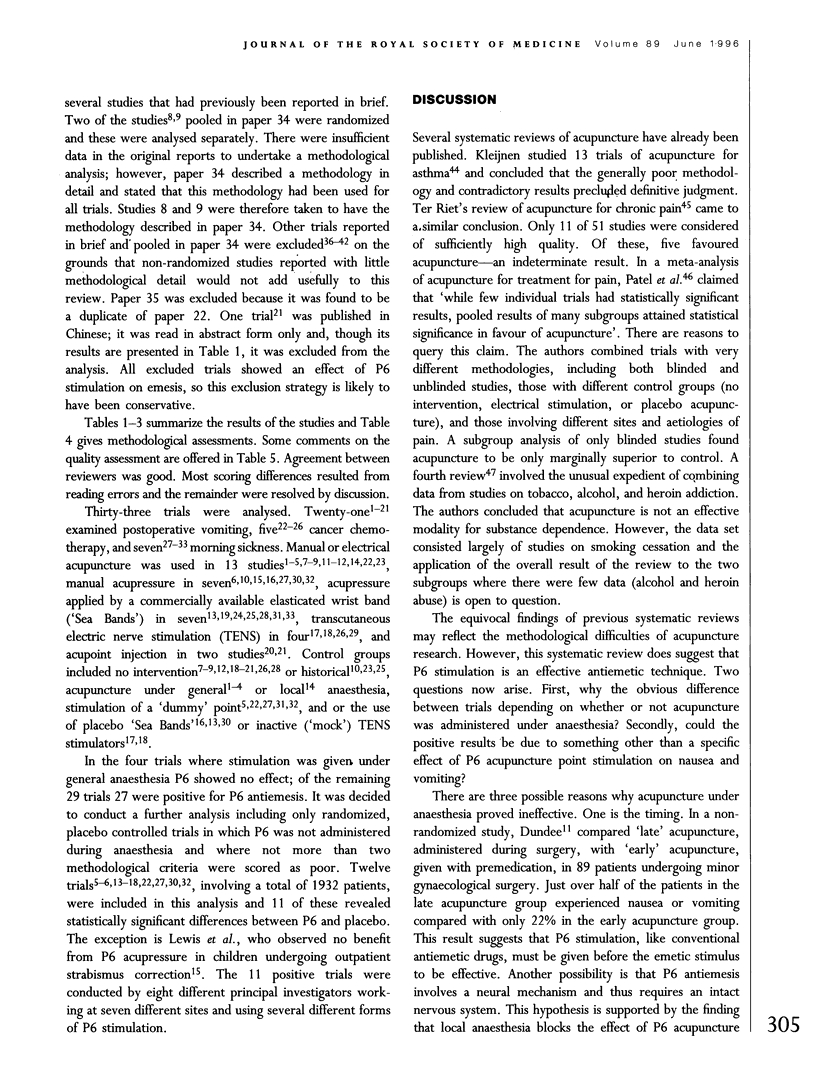
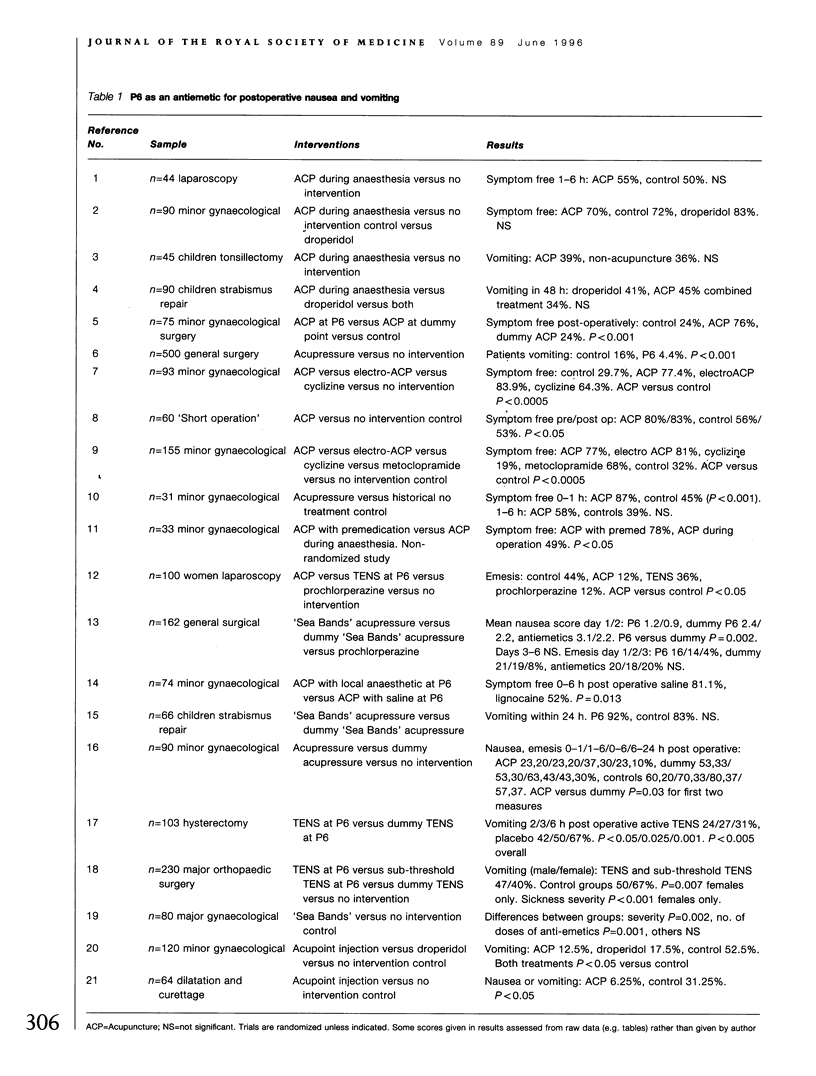
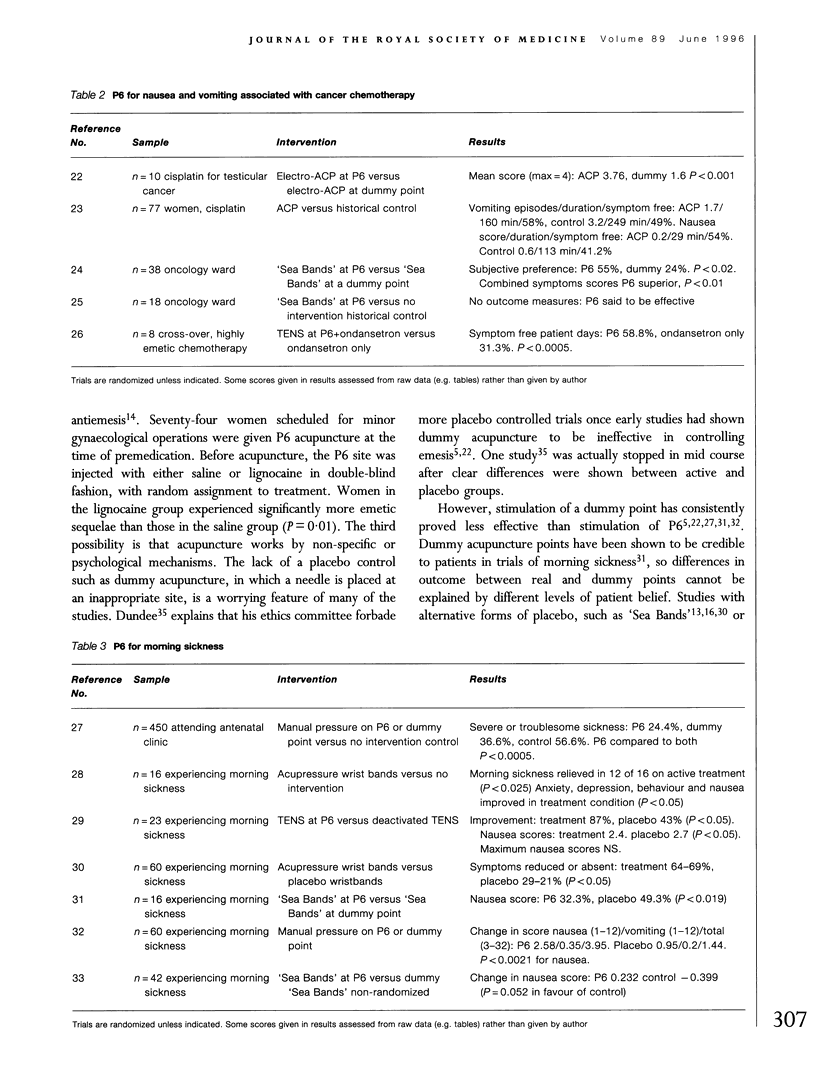
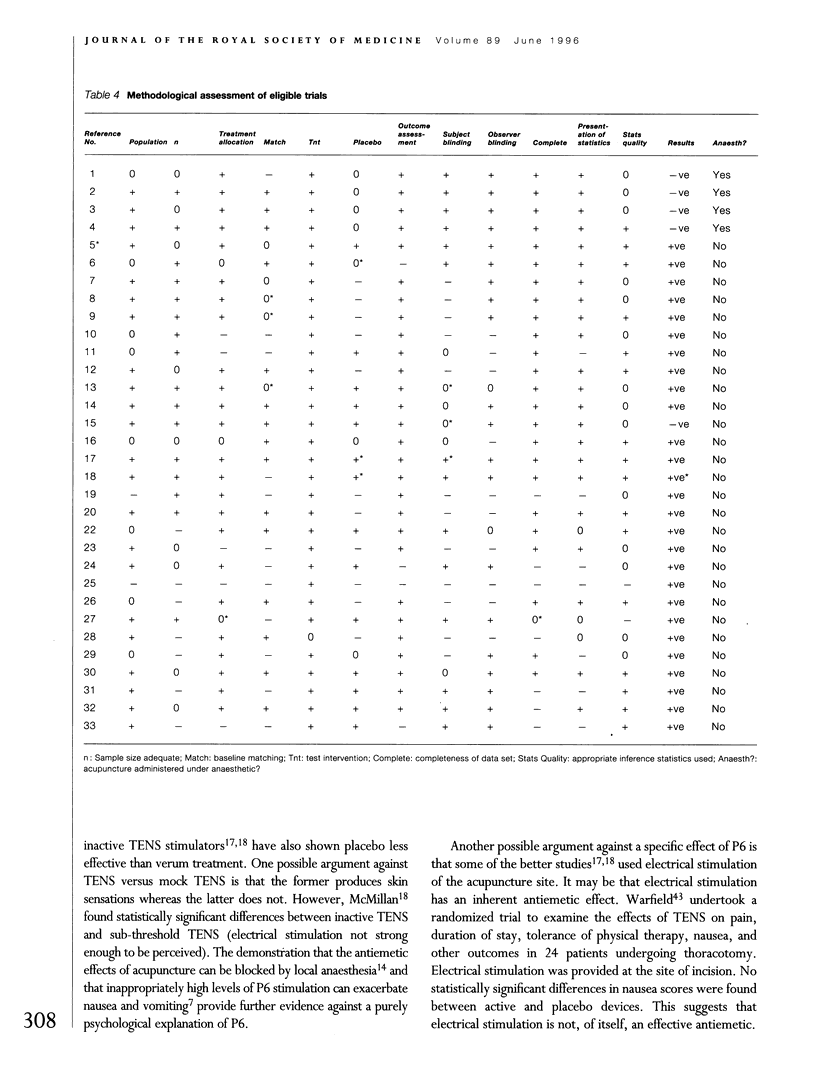
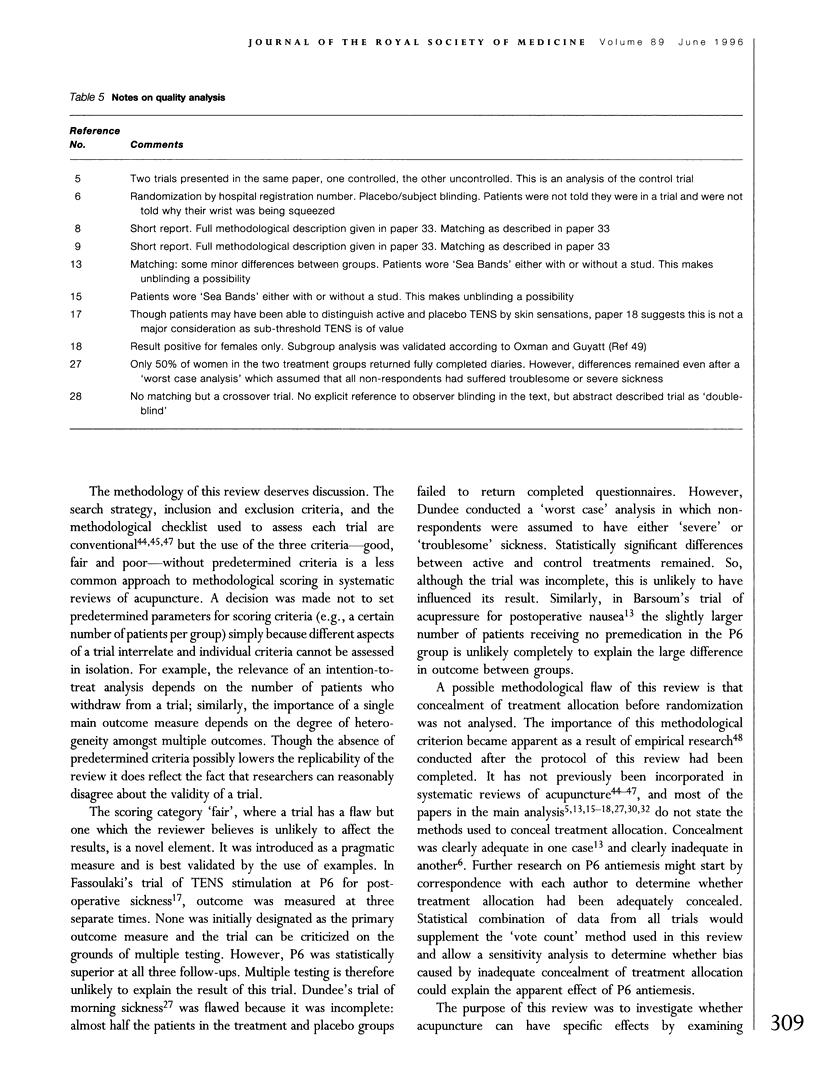
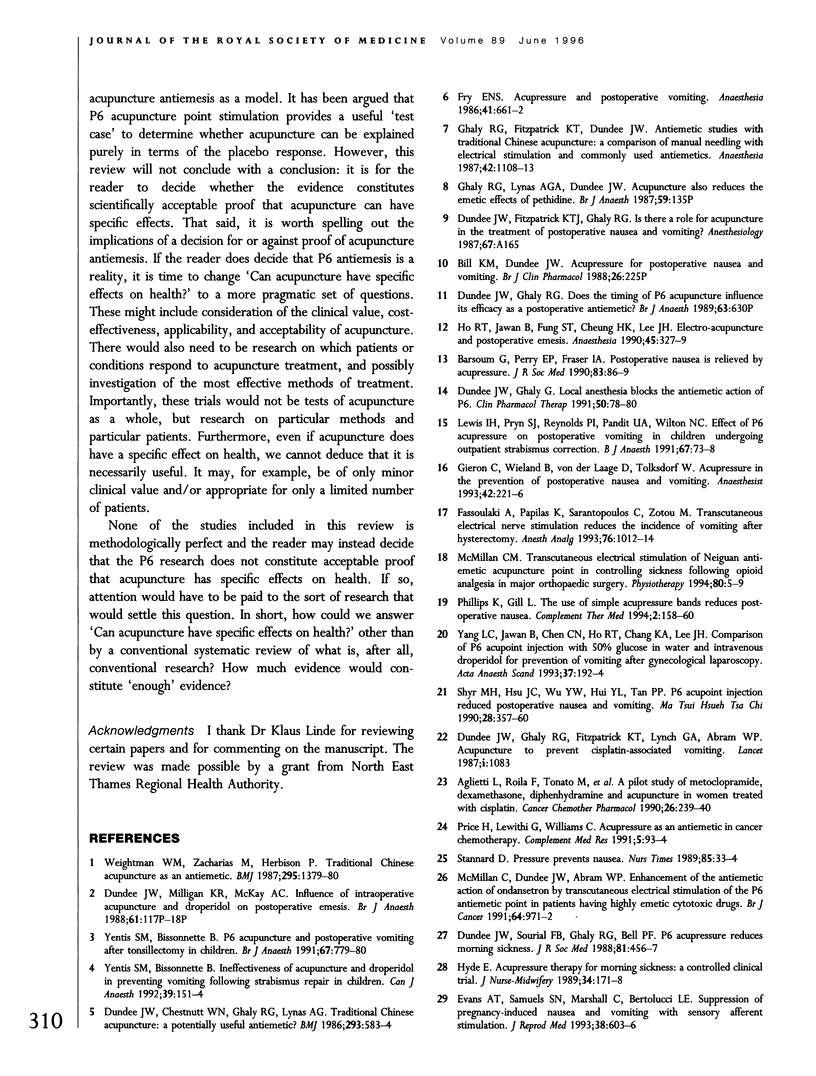
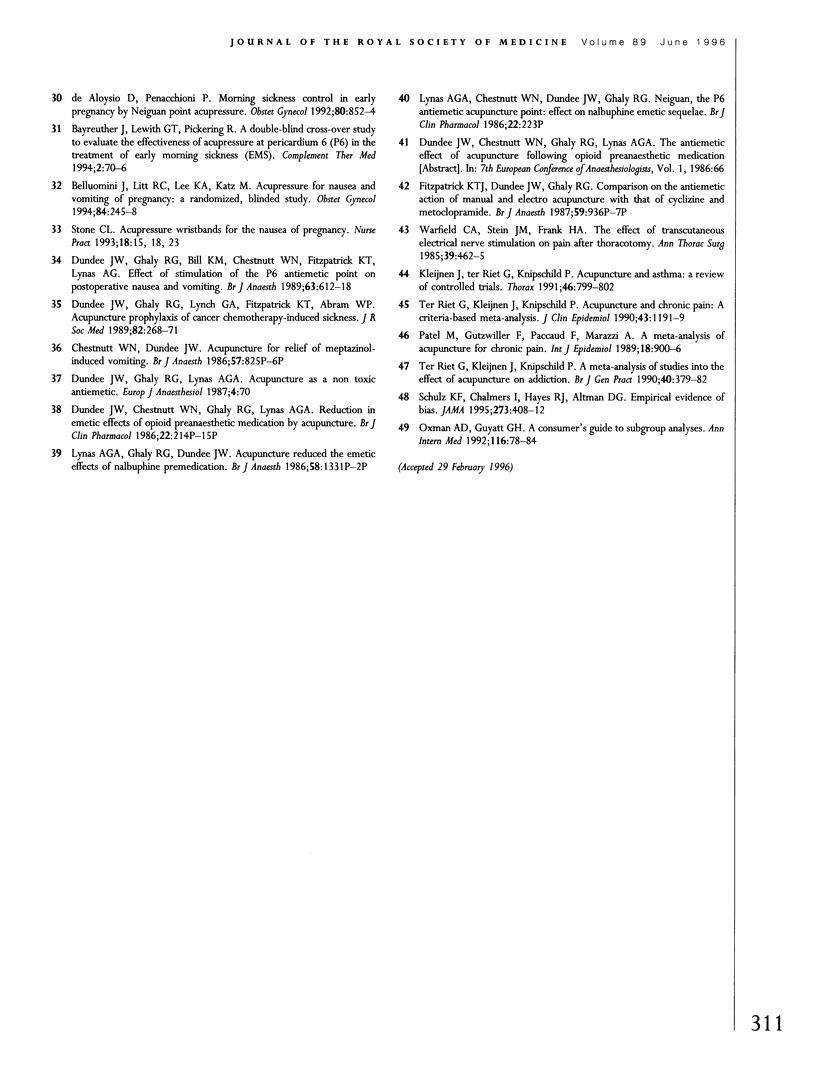
Selected References
These references are in PubMed. This may not be the complete list of references from this article.
- Aglietti L., Roila F., Tonato M., Basurto C., Bracarda S., Picciafuoco M., Ballatori E., Del Favero A. A pilot study of metoclopramide, dexamethasone, diphenhydramine and acupuncture in women treated with cisplatin. Cancer Chemother Pharmacol. 1990;26(3):239–240. doi: 10.1007/BF02897209. [DOI] [PubMed] [Google Scholar]
- Barsoum G., Perry E. P., Fraser I. A. Postoperative nausea is relieved by acupressure. J R Soc Med. 1990 Feb;83(2):86–89. doi: 10.1177/014107689008300209. [DOI] [PMC free article] [PubMed] [Google Scholar]
- Belluomini J., Litt R. C., Lee K. A., Katz M. Acupressure for nausea and vomiting of pregnancy: a randomized, blinded study. Obstet Gynecol. 1994 Aug;84(2):245–248. [PubMed] [Google Scholar]
- Dundee J. W., Chestnutt W. N., Ghaly R. G., Lynas A. G. Traditional Chinese acupuncture: a potentially useful antiemetic? Br Med J (Clin Res Ed) 1986 Sep 6;293(6547):583–584. doi: 10.1136/bmj.293.6547.583. [DOI] [PMC free article] [PubMed] [Google Scholar]
- Dundee J. W., Ghaly G. Local anesthesia blocks the antiemetic action of P6 acupuncture. Clin Pharmacol Ther. 1991 Jul;50(1):78–80. doi: 10.1038/clpt.1991.106. [DOI] [PubMed] [Google Scholar]
- Dundee J. W., Ghaly R. G., Bill K. M., Chestnutt W. N., Fitzpatrick K. T., Lynas A. G. Effect of stimulation of the P6 antiemetic point on postoperative nausea and vomiting. Br J Anaesth. 1989 Nov;63(5):612–618. doi: 10.1093/bja/63.5.612. [DOI] [PubMed] [Google Scholar]
- Dundee J. W., Ghaly R. G., Fitzpatrick K. T., Abram W. P., Lynch G. A. Acupuncture prophylaxis of cancer chemotherapy-induced sickness. J R Soc Med. 1989 May;82(5):268–271. doi: 10.1177/014107688908200508. [DOI] [PMC free article] [PubMed] [Google Scholar]
- Dundee J. W., Ghaly R. G., Fitzpatrick K. T., Lynch G. A., Abram W. P. Acupuncture to prevent cisplatin-associated vomiting. Lancet. 1987 May 9;1(8541):1083–1083. doi: 10.1016/s0140-6736(87)90501-0. [DOI] [PubMed] [Google Scholar]
- Dundee J. W., Sourial F. B., Ghaly R. G., Bell P. F. P6 acupressure reduces morning sickness. J R Soc Med. 1988 Aug;81(8):456–457. doi: 10.1177/014107688808100813. [DOI] [PMC free article] [PubMed] [Google Scholar]
- Evans A. T., Samuels S. N., Marshall C., Bertolucci L. E. Suppression of pregnancy-induced nausea and vomiting with sensory afferent stimulation. J Reprod Med. 1993 Aug;38(8):603–606. [PubMed] [Google Scholar]
- Fassoulaki A., Papilas K., Sarantopoulos C., Zotou M. Transcutaneous electrical nerve stimulation reduces the incidence of vomiting after hysterectomy. Anesth Analg. 1993 May;76(5):1012–1014. doi: 10.1213/00000539-199305000-00017. [DOI] [PubMed] [Google Scholar]
- Fry E. N. Acupressure and postoperative vomiting. Anaesthesia. 1986 Jun;41(6):661–662. doi: 10.1111/j.1365-2044.1986.tb13083.x. [DOI] [PubMed] [Google Scholar]
- Gieron C., Wieland B., von der Laage D., Tolksdorf W. Akupressur zur Prophylaxe postoperativer Ubelkeit und Erbrechen. Anaesthesist. 1993 Apr;42(4):221–226. [PubMed] [Google Scholar]
- Ho R. T., Jawan B., Fung S. T., Cheung H. K., Lee J. H. Electro-acupuncture and postoperative emesis. Anaesthesia. 1990 Apr;45(4):327–329. doi: 10.1111/j.1365-2044.1990.tb14744.x. [DOI] [PubMed] [Google Scholar]
- Hyde E. Acupressure therapy for morning sickness. A controlled clinical trial. J Nurse Midwifery. 1989 Jul-Aug;34(4):171–178. doi: 10.1016/0091-2182(89)90077-3. [DOI] [PubMed] [Google Scholar]
- Jones R. M., Rosen M., Seymour L. Smoking and anaesthesia. Anaesthesia. 1987 Jan;42(1):1–2. doi: 10.1111/j.1365-2044.1987.tb02935.x. [DOI] [PubMed] [Google Scholar]
- Kleijnen J., ter Riet G., Knipschild P. Acupuncture and asthma: a review of controlled trials. Thorax. 1991 Nov;46(11):799–802. doi: 10.1136/thx.46.11.799. [DOI] [PMC free article] [PubMed] [Google Scholar]
- Lewis I. H., Pryn S. J., Reynolds P. I., Pandit U. A., Wilton N. C. Effect of P6 acupressure on postoperative vomiting in children undergoing outpatient strabismus correction. Br J Anaesth. 1991 Jul;67(1):73–78. doi: 10.1093/bja/67.1.73. [DOI] [PubMed] [Google Scholar]
- McMillan C., Dundee J. W., Abram W. P. Enhancement of the antiemetic action of ondansetron by transcutaneous electrical stimulation of the P6 antiemetic point, in patients having highly emetic cytotoxic drugs. Br J Cancer. 1991 Nov;64(5):971–972. doi: 10.1038/bjc.1991.439. [DOI] [PMC free article] [PubMed] [Google Scholar]
- Oxman A. D., Guyatt G. H. A consumer's guide to subgroup analyses. Ann Intern Med. 1992 Jan 1;116(1):78–84. doi: 10.7326/0003-4819-116-1-78. [DOI] [PubMed] [Google Scholar]
- Patel M., Gutzwiller F., Paccaud F., Marazzi A. A meta-analysis of acupuncture for chronic pain. Int J Epidemiol. 1989 Dec;18(4):900–906. doi: 10.1093/ije/18.4.900. [DOI] [PubMed] [Google Scholar]
- Schulz K. F., Chalmers I., Hayes R. J., Altman D. G. Empirical evidence of bias. Dimensions of methodological quality associated with estimates of treatment effects in controlled trials. JAMA. 1995 Feb 1;273(5):408–412. doi: 10.1001/jama.273.5.408. [DOI] [PubMed] [Google Scholar]
- Shyr M. H., Hsu J. C., Wu Y. W., Hui Y. L., Tan P. P. [P6 acupoint injection reduced postoperative nausea and vomiting]. Ma Zui Xue Za Zhi. 1990 Sep;28(3):357–360. [PubMed] [Google Scholar]
- Stannard D. Pressure prevents nausea. Nurs Times. 1989 Jan 25;85(4):33–34. [PubMed] [Google Scholar]
- Stone C. L. Acupressure wristbands for the nausea of pregnancy. Nurse Pract. 1993 Nov;18(11):15–23. doi: 10.1097/00006205-199311000-00006. [DOI] [PubMed] [Google Scholar]
- Ter Riet G., Kleijnen J., Knipschild P. A meta-analysis of studies into the effect of acupuncture on addiction. Br J Gen Pract. 1990 Sep;40(338):379–382. [PMC free article] [PubMed] [Google Scholar]
- Warfield C. A., Stein J. M., Frank H. A. The effect of transcutaneous electrical nerve stimulation on pain after thoracotomy. Ann Thorac Surg. 1985 May;39(5):462–465. doi: 10.1016/s0003-4975(10)61957-1. [DOI] [PubMed] [Google Scholar]
- Weightman W. M., Zacharias M., Herbison P. Traditional Chinese acupuncture as an antiemetic. Br Med J (Clin Res Ed) 1987 Nov 28;295(6610):1379–1380. doi: 10.1136/bmj.295.6610.1379. [DOI] [PMC free article] [PubMed] [Google Scholar]
- Yang L. C., Jawan B., Chen C. N., Ho R. T., Chang K. A., Lee J. H. Comparison of P6 acupoint injection with 50% glucose in water and intravenous droperidol for prevention of vomiting after gynecological laparoscopy. Acta Anaesthesiol Scand. 1993 Feb;37(2):192–194. doi: 10.1111/j.1399-6576.1993.tb03699.x. [DOI] [PubMed] [Google Scholar]
- Yentis S. M., Bissonnette B. Ineffectiveness of acupuncture and droperidol in preventing vomiting following strabismus repair in children. Can J Anaesth. 1992 Feb;39(2):151–154. doi: 10.1007/BF03008646. [DOI] [PubMed] [Google Scholar]
- Yentis S. M., Bissonnette B. P6 acupuncture and postoperative vomiting after tonsillectomy in children. Br J Anaesth. 1991 Dec;67(6):779–780. doi: 10.1093/bja/67.6.779. [DOI] [PubMed] [Google Scholar]
- de Aloysio D., Penacchioni P. Morning sickness control in early pregnancy by Neiguan point acupressure. Obstet Gynecol. 1992 Nov;80(5):852–854. [PubMed] [Google Scholar]
- ter Riet G., Kleijnen J., Knipschild P. Acupuncture and chronic pain: a criteria-based meta-analysis. J Clin Epidemiol. 1990;43(11):1191–1199. doi: 10.1016/0895-4356(90)90020-p. [DOI] [PubMed] [Google Scholar]


